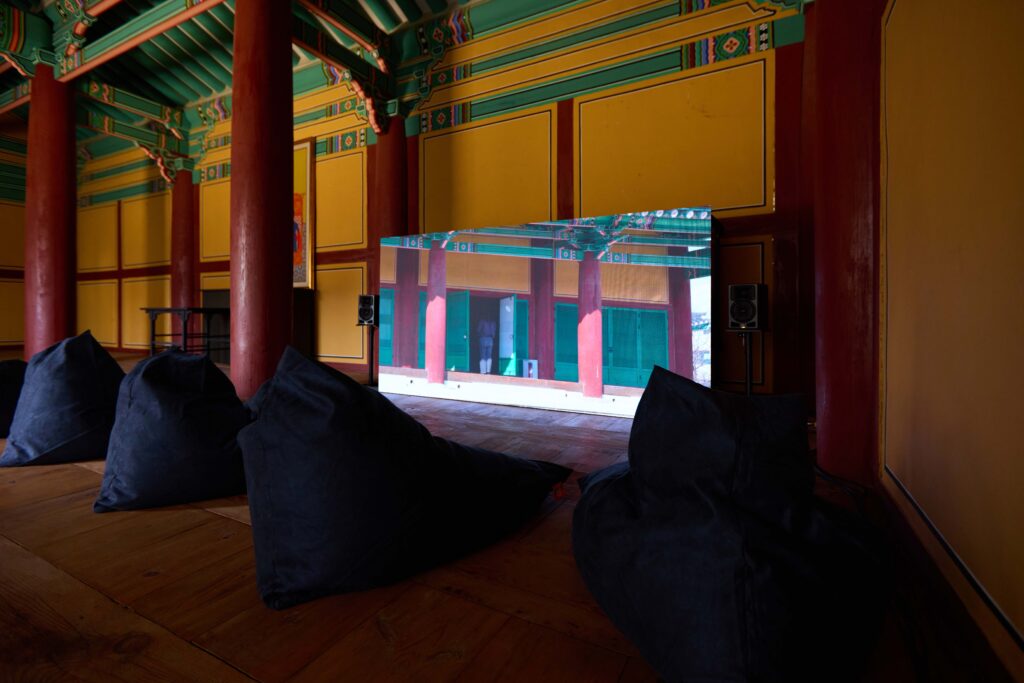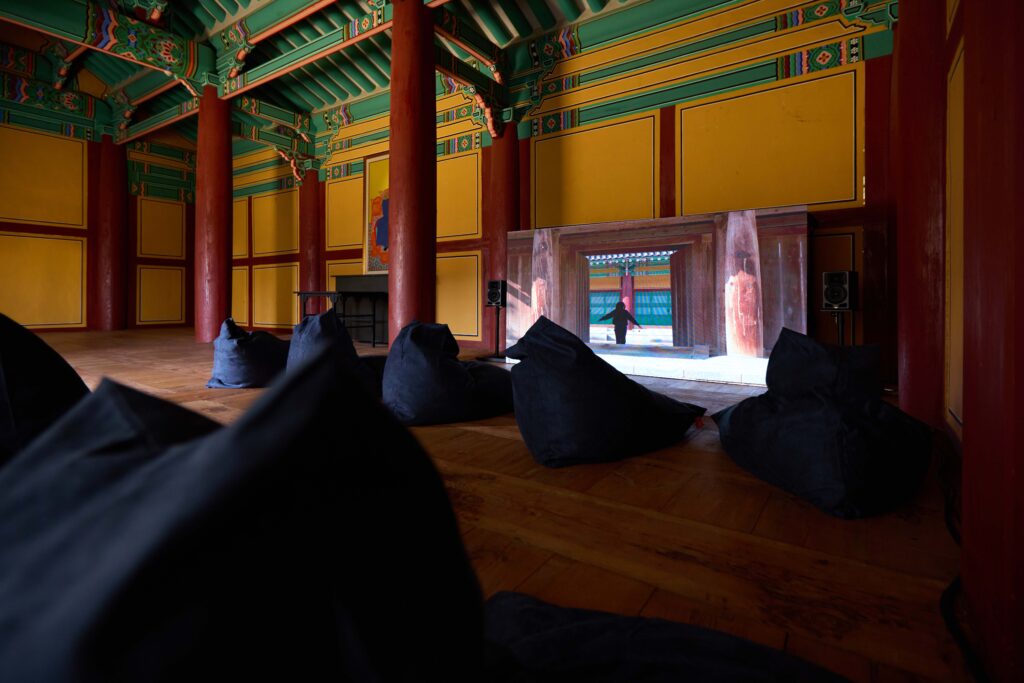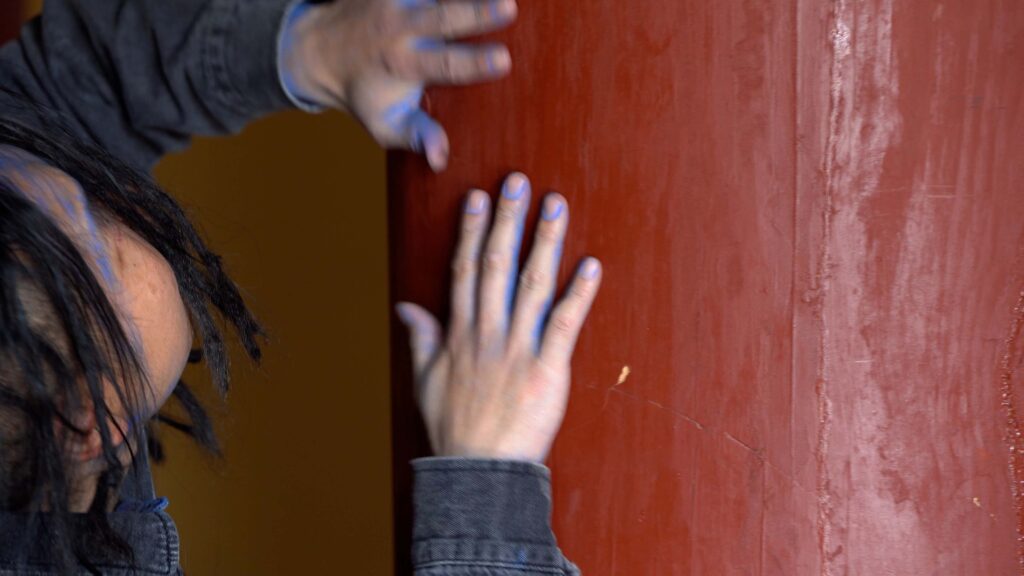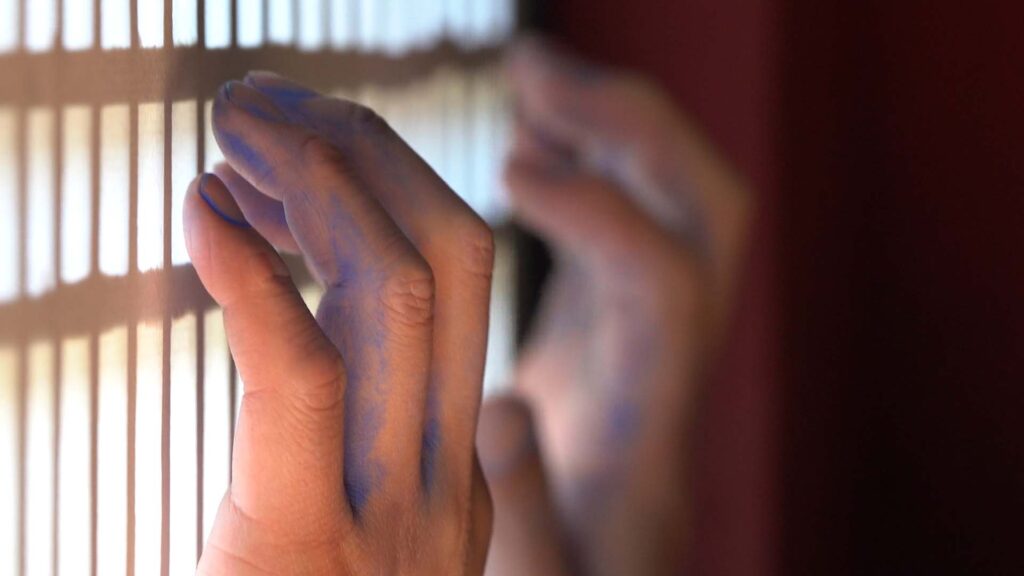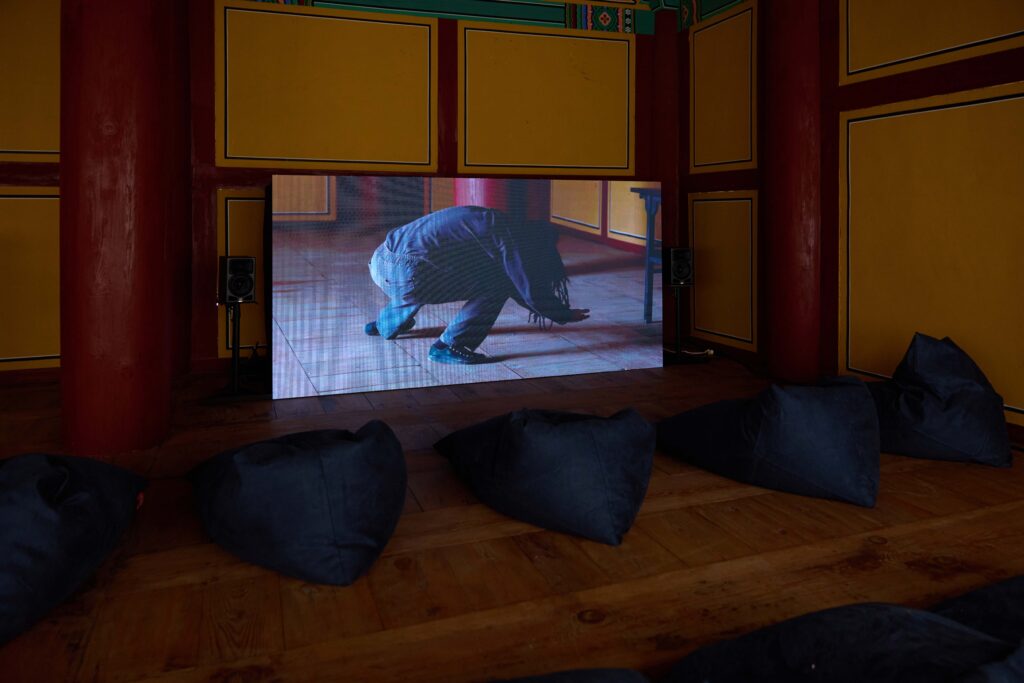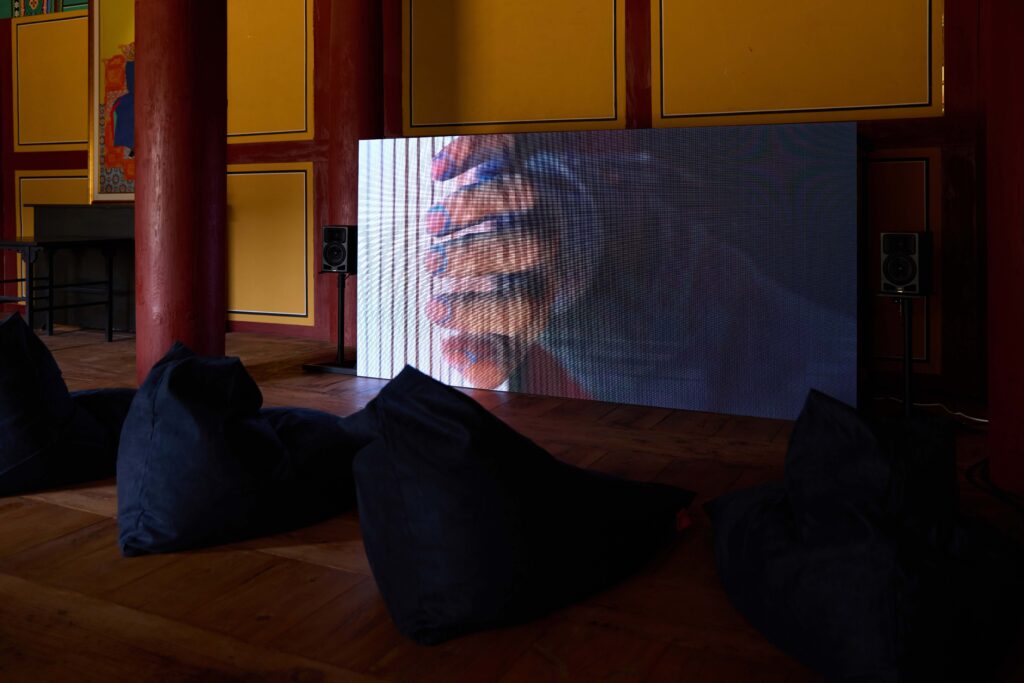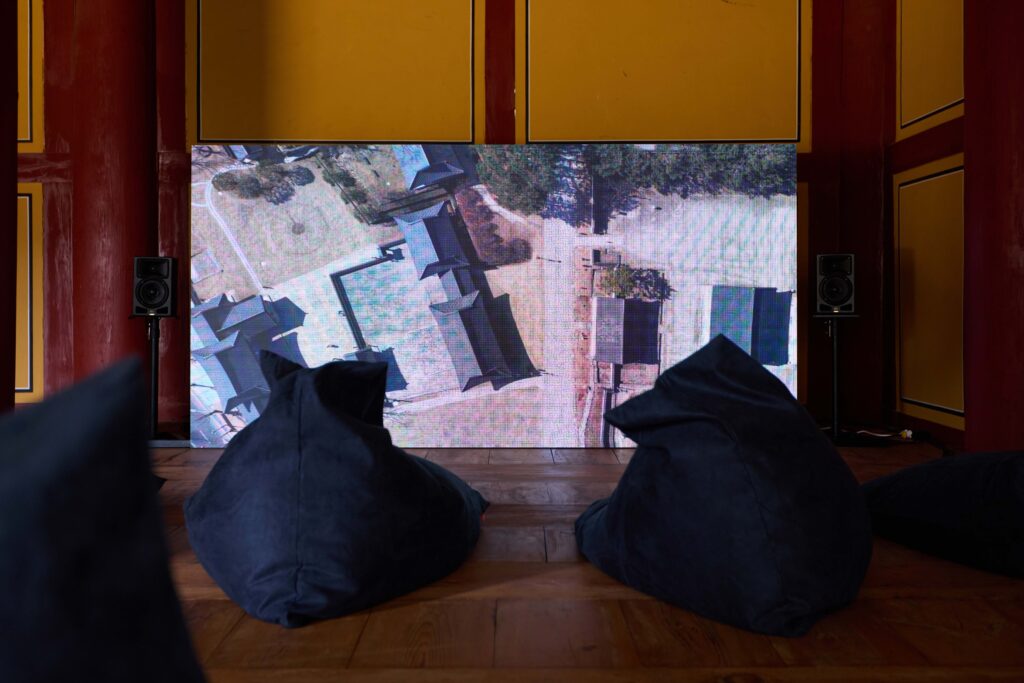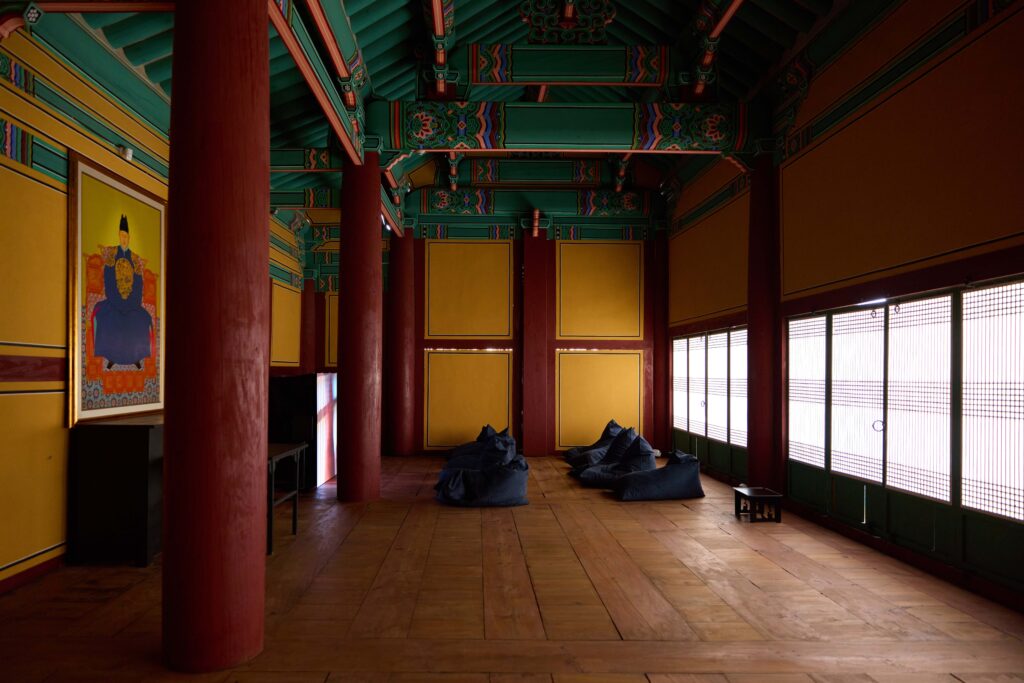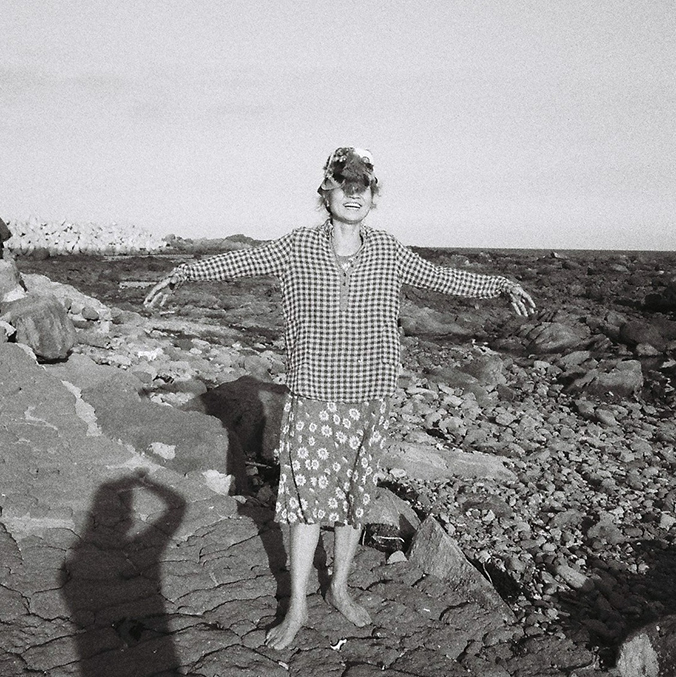EXHIBITION
ARTIST
- What You are Touching Now- Gangneung, 2025, single-channel video, color, sound, 13min 3sec.
Hong Lee Hyunsook’s works intertwine sculpture, installation, video, and performance, often exploring physical engagement with space and social narratives. In What You Are Touching Now – Gangneung, Hong Lee Hyunsook presents a video documentation of a percussion-based performance staged within the historic architecture in Gangneung including The Main Gate of Imyeonggwan Guesthouse, Gangneung, Chilsadang Hall, and Inner Hall. Treating these buildings as nonhuman bodies that have long borne witness to the city’s history, the artist awakens their dormant vitality and memory through acts of rhythmic drumming. Through this performative gesture, a ritual structure emerges—one that merges nature, recovery, and the pulse of life. The work encapsulates Hong Lee’s ongoing engagement with bodily discipline, rituality, and the boundary between human and nonhuman beings.
The performance unfolds as a ritual of resonance, where space, body, and nature serve as vessels of reciprocal feeling. The Main Gate of Imyeonggwan Guesthouse, Gangneung and Chilsadang Hall stand as sacred entities imbued with layers of time and memory; drumming them becomes a form of invocation, an effort to stir and commune with these presences. In doing so, the artist channels the sacredness and temporality embedded in architecture, calling forth a renewed relationship between human and nonhuman. This approach resonates with the tradition of a coastal shamanic ritual practiced along Korea’s east coast (byeolsingut). Gangneung, with its deep-rooted shamanic heritage, has long preserved ritual cultures that imbue natural and architectural structures with sacred meaning. While Hong Lee does not directly use the structure of byeolsingut, she invokes its gestures and rhythms.
At the heart of the work are the Inner Hall and the main hall of the former provincial government office (Gangneung-daedohobu Government Office), treated as an instrument and a body. The artist draws inspiration from the opening moments of the traditional byeolsingut, in which a shaman (mudang) uses percussion instruments to awaken the space before the ritual begins. The transmission of these vibrations signals the beginning of something to those far beyond. In traditional shamanic ritual (gut), the choice of percussion instruments—such as jing, janggu, or kkwaenggwari—helps determine the identity of the entities summoned, transforming the act of drumming from mere sound into a symbolic gesture of awakening.
Based on this logic of traditional shamanic ritual, the artist reimagines old architecture like the Main Gate of Imyeonggwan Guesthouse, Gangneung and Chilsadang Hall as sacred bodies, transforming them into responsive, living entities. Window paper, columns, walls, and floorboards behave like internal organs, resonating with the performer’s rhythm. Wind, trees, mountains, and the sea echo this invocation in turn. Here, the architecture no longer serves as a backdrop but emerges as an active participant, a living organism animated by the ritual act of drumming. The performance becomes a site of resonance where humans and nonhumans converge.
Two performers appear in the work. One takes on the role of the drummer—a ritualist or shaman figure who channels energy through the body and into the architecture. Using no instruments, this performer creates rhythm through direct contact between their body and the structure. The other performer becomes the offering—the sacrificial body—who embraces tension through gestures of surrender. Together, they move between the roles of subject and object, conjurer and offering, person and place. Referencing the Korean mythological figures of Cheo Yong and Sim Cheong, the performance reinterprets their respective archetypes—the banisher of evil and the self-sacrificing daughter—into a contemporary ritual form.
The structure of the performance also echoes Korean myths that confront calamity. Like Cheo Yong, the drummer repels malevolent forces through rhythmic ritual; like Sim Cheong, the offering figure realizes sacrifice by throwing oneself into the sea. Beyond symbolic reference, this work is grounded in the tangible threats that hover over Gangneung, particularly wildfires that imperil the region’s four sacred peaks. In this context, the performance responds to disaster not only metaphorically but viscerally.
Drumming becomes a gesture that carries the body of the present into the presence of the past, generating a threshold where past and present intersect. As the intensity builds, the trembling of architecture and performer merge, and the memories held within the site are revived through sensory encounters. These tremors resonate with the spirituality of Gangneung’s four mountains—Daegwallyeong, Nochusan, Gyebangsan, and Odaesan— long revered as protectors of the region. The rhythm of the performance becomes a medium for their vital force, while also responding to destructive natural forces, wildfires among them, that threaten their presence. In this way, the performance operates as both invocation and purification.
This ritual structure is also reflected in the work’s use of color. Blue functions as both emotional anchor and symbolic device. From the hue of the offering and the sea to a blue pit unexpectedly captured by drone—each instance evokes sacrifice, cleansing, and healing, forming the chromatic pulse of the film. Like the sea into which Sim Cheong gave herself, the color blue opens a passageway into the ritual, drawing out the site’s primal force.
Ultimately, What You Are Touching Now – Gangneung is a ritual of remembrance. By interweaving architecture and body, ritual and myth, the work conjures a present-day invocation that awakens the narratives embedded in the land. At the intersection of human and nonhuman, calamity and recovery, the artist performs a primal gesture of drumming as a contemporary act of invocation.
Hong Lee Hyunsook (b.1958) explores abstraction through daily practice and training, aiming to decenter the human-centric existence. By transcending sensory experiences, including smell, sound, and vibration, she seeks to create a multisensory space where humans and non-humans coexist and interact. Having majored in sculpture, Hong Lee works across various media, including video installation, performance, and photography.
Hong Lee’s major solo exhibitions include At 12m below the ground level, Spectacle of Species (Coreana Museum of Art, 2022), Swoosh, Tsu-pu! (Arko Art Center, 2021), Midday Seungga Temple (space illi, 2019), and Menopause Ceremony Project (emu Artspace, 2012). Her major group exhibitions include 2024 Title Match: Hong Lee, Hyunsook vs. Ji Hye Yeom: Fold the Time with the Ground (Buk-Seoul Museum of Art, 2024), the Busan Biennale 2024 Seeing in the Dark (Busan Museum of Contemporary Art, 2024), Connecting Bodies – Asian Women Artists (National Museum of Modern and Contemporary Art, 2024), and the 14th Gwangju Biennale, soft and weak like water (Mugak Temple, 2023). She also participated in the Gangneung International Art Festival 2022 (GIAF22) Tale of a City (Seobu Market Yejip, 2022)
Instagram: @hong_hyun_sook
